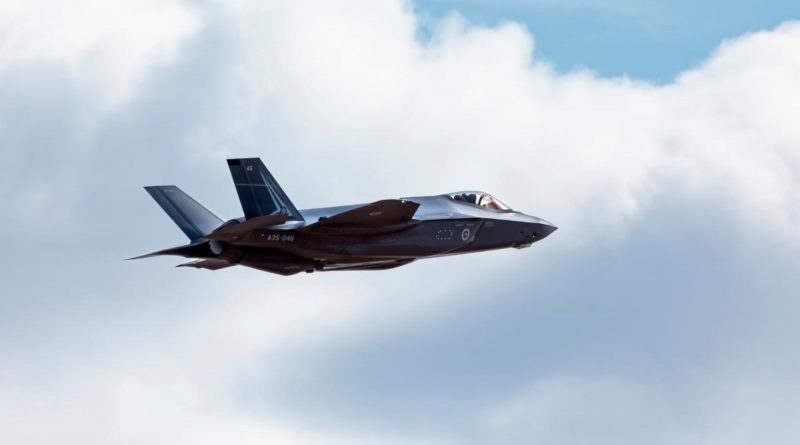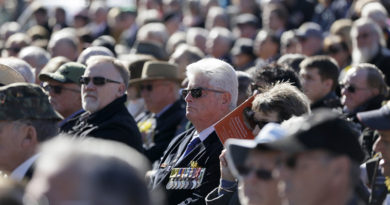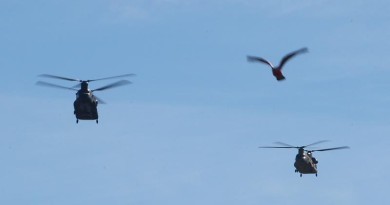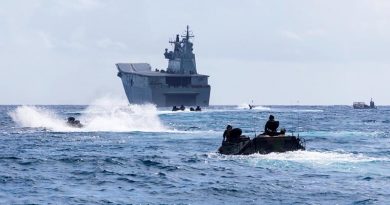RAAF’s first fifth-generation fighter combat instructors
Share the post "RAAF’s first fifth-generation fighter combat instructors"

Each Air Warfare Instructor Course (AWIC) includes a Fighter Combat Instructor (FCI) course, which debuted for the RAAF’s F-35A Lightning II this year.
CAPTION: A Royal Australian Air Force F-35A Lightning ll departs from RAAF Base Tindal during Exercise Diamond Storm 2022. Story by Squadron Leader Eamon Hamilton. Photo by Leading Aircraftman Samuel Miller.
Commanding Officer of No. 2 Operational Conversion Unit Wing Commander Jordan Sander spoke to Squadron Leader Eamon Hamilton about bringing a fifth-generation fighter capability into AWIC.
.
.
What planning was required in creating the first F-35A FCI course?
The detailed planning for the first course began in January 2021, a year before AWIC22 began.
No. 81 Wing selected an F-35A course director who was responsible for developing the high-level structure of the course.
Determining how many sims and flights would be required for the F-35A FCI course included the learning outcomes and the resources required, which includes the airspace, Red Air elements and ground threats.
The course director then delegated the development of mission specific detail to several phase commanders.
Phase commanders are given responsibility for a section of the course containing several flights and sims.
It was a tremendous amount of work and we are very proud of what we achieved.
The quality of the first F-35A FCI course exceeded my expectations reflecting the technical competence and devotion to duty of our staff.
Like anything in the Royal Australian Air Force, there are many people behind the scenes who make this all possible.
Our operations, mission support, security, orderly room, logistics, off-board information systems and maintenance staff; the workforce is a mix of uniformed, public servant, and contractor.
The hardest thing has been doing this in the middle of a transition as we’re still bringing the F-35A into service.
This transition has meant there are low experience levels and a new aircraft type where things are often new or unknown.
Lastly, our relationship with key personnel within the USAF Weapons School (at Nellis Air Force Base in Nevada) has been key in both tactics and FCI course development.
These relationships began with our own conversion onto the F-35A (completed with the 61st Fighter Squadron at Luke Air Force Base in Arizona), and it’s critical we are proactive to maintain them.

CAPTION: Avionics Technician Leading Aircraftman Timothy Briggs, from No. 2 Operational Conversion Unit, inspects the exterior of a F-35A Lightning II aircraft in the ordnance loading area at RAAF Base Darwin, Northern Territory, during Exercise Diamond Storm 2022. Photo by Leading Aircraftman Sam Price.
Was the F-35A FCI course content created brand new, adapted from an existing curriculum, or did it fall somewhere in between?
The overall flow of the course remains unchanged.
We start by focusing on the candidates’ instructional skills before we move onto air-to-air, ending in a defensive counter-air exercise called Diamond Shield.
We then conduct air-to-surface skills training ending in a large offensive exercise called Diamond Storm.
Everything below this high-level course flow needed to be adapted to F-35A and the threat identified for the course.
Given we only run this course every two to three years, the course needs to be constantly rewritten with ongoing upgrades and changes to our capabilities, the threat and therefore our tactics.
For the F-35A particularly, the simulator is more capable than Classic Hornet, and the F-35A has a significant capability against ground-based air defences (GBADS) – so this course has incorporated many missions against them.
Creating these challenging missions is not without its issues; every time we fly, we need to do so against a capable adversary.
In this regard, 2OCU has been incredibly well supported by numerous units across Defence.
These include other F-35A squadrons who provide the adversary air threats, and contractor operated ground-based systems that represent surface-to-air missiles.
Without the level of complexity that these assets provide it is hard to truly challenge the F-35A and the students.
What are the F-35A’s inherent strengths that make it particularly well suited for missions the FCI candidates face?
The F-35A’s biggest strength is its missions systems and its ability to build situational awareness on the battlefield for the joint force.
The stealth of the aircraft also improves both our survivability and lethality against advanced threats.
Lastly, F-35A’s high internal fuel has also given us more options in how we refuel the air package overall.
Are we learning anything new about how we integrate the F-35A through the course of AWIC?
Only when we place our F-35A pilots in an integrated joint force do we properly understand the integration aspects.
The first aspect of achieving integration is communication – we must speak a common language.
We must understand how our datalinks interact with each other’s platforms, made more challenging by the constantly changing nature of datalink standards and platform software.
Most importantly, we must maintain strong relationships across RAAF and Defence.
With communication mastered we must have integrated tactical procedures that define how we fight together.
Is there anything else you wish to address?
AWIC has delivered an integrated force like never before, and this is a credit to No. 88 Squadron and the Air Warfare Centre.
Advanced capabilities like F-35A are nothing without the people who operate them.
AWIC has ensured our next tactical experts are ready to lead us as an integrated joint force.
.
.

.
.
Share the post "RAAF’s first fifth-generation fighter combat instructors"





